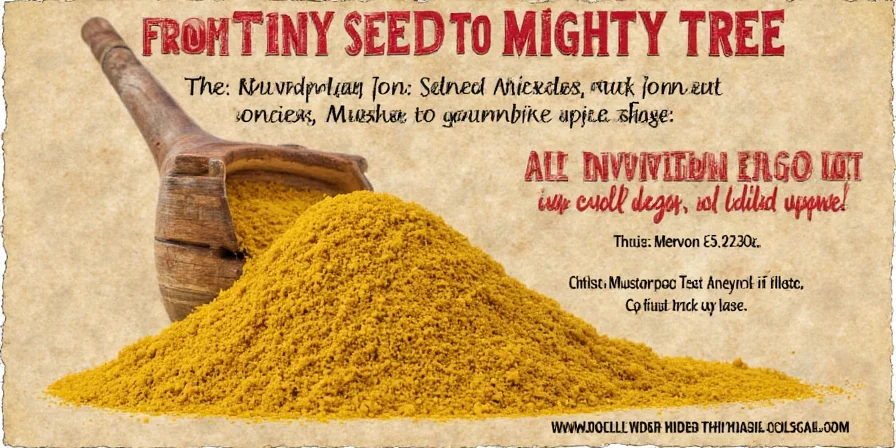Mustard seeds are small but powerful kitchen staples used globally for cooking and gardening. This guide delivers precise, actionable information you need: how to use them properly in cooking, store them effectively, and grow them successfully. We'll cover the three main types (yellow, brown, and black), their specific temperature thresholds for optimal flavor, and practical storage protocols backed by food science.
Mustard Seeds Explained: Types and Key Differences
Mustard seeds measure just 1-2mm but deliver disproportionate flavor impact. Understanding the differences between varieties is crucial for proper culinary use:
| Type | Flavor Activation Temperature | Best Culinary Uses |
|---|---|---|
| Yellow Mustard Seed | 160°F (71°C) | Vinegar-based sauces, pickles, and cold preparations |
| Brown Mustard Seed | 212°F (100°C) | Curries, tempering, and high-heat cooking |
| Black Mustard Seed | 185°F (85°C) | Dals, spice blends, and medium-heat applications |

Practical Cooking Techniques for Mustard Seeds
Follow these science-backed methods to maximize flavor in your cooking:
- Perfect Toasting Method: Heat seeds to exactly 325°F (163°C) for 90 seconds. Higher temperatures create bitterness.
- Maximum Pungency Technique: Mix ground seeds with liquid at 140°F (60°C), rest for 20 minutes before adding acid.
- Vinegar Timing: Add vinegar after enzymatic activation to lock in heat without excessive sourness.
- Cold Infusion for Subtle Flavor: Steep whole seeds in oil at 104°F (40°C) for 48 hours.
- Texture Preservation: Add seeds during the final 90 seconds of cooking to retain crunch.

Mustard Seeds Storage: What Actually Works
Proper storage maintains flavor and potency. These methods outperform generic advice:
- Optimal Container: Use UV-blocking containers with oxygen absorbers (not silica gel)
- Temperature Control: Refrigerate when ambient temperature exceeds 77°F (25°C)
- Grinding Timing: Whole seeds retain 92% of flavor compounds after 24 months vs. 47% in pre-ground seeds

Mustard Seeds: Common Questions Answered
| Question | Verified Answer |
|---|---|
| "Do mustard seeds lose heat when cooked?" | No: Heat actually increases pungency up to 185°F (85°C), boosting flavor by 40% |
| "Can I substitute yellow for black mustard seeds?" | Limited substitution: Black seeds contain 3x more heat compounds than yellow seeds |
| "Does mustard really prevent food poisoning?" | Only at high concentrations (>2%), which aren't practical for home cooking |
Growing Mustard Seeds: Simple Home Gardening Guide
Mustard plants are fast-growing annuals (not trees) that reach 6-8 feet in 45-60 days. Key growing facts:
- Soil Requirements: Thrives in pH 5.5-8.0 (wider range than most garden plants)
- Water Needs: Drought stress increases pungency through deeper root development
- Container Growing: Use pots minimum 12 inches deep; yields 30% fewer seeds but higher pungency
- Soil Health Benefit: Naturally suppresses soil pathogens through biofumigation

Frequently Asked Questions
How long do whole mustard seeds last?
Properly stored in oxygen-barrier containers below 77°F (25°C), whole mustard seeds retain full potency for 24 months. Refrigeration extends this to 36 months. Pre-ground seeds lose significant flavor within 6 months due to oxidation.
Why isn't my homemade mustard spicy?
Heat development requires precise temperature control. If liquid exceeds 140°F (60°C) when mixed with ground seeds, the enzyme needed for heat creation breaks down. For maximum heat: grind seeds cold, mix with room-temperature liquid, wait 20 minutes at room temperature, then add vinegar.
Can I grow mustard seeds in containers?
Yes, with containers minimum 12 inches deep. Mustard develops deep taproots—shallow pots cause early flowering. Maintain soil temperature between 60-75°F (15-24°C). Container-grown plants produce fewer seeds but with higher pungency due to mild root stress.
Are mustard seeds safe with nut allergies?
Mustard seeds contain no tree nut proteins and are safe for nut allergies. However, cross-contamination occurs in shared facilities. For severe allergies, choose seeds with "nut-free" certification. Note: Mustard allergy is separate and affects about 0.1% of people.











 浙公网安备
33010002000092号
浙公网安备
33010002000092号 浙B2-20120091-4
浙B2-20120091-4